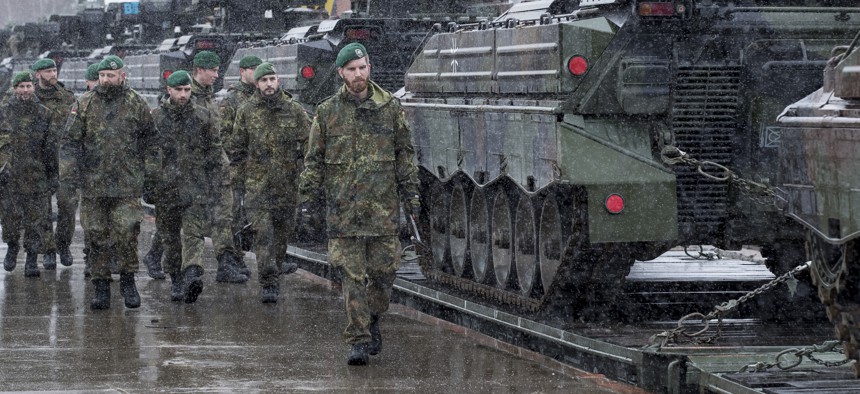
Troops from Germany's 12th Mechanised Infantry Brigade walks past Marder 1A4/3 military vehicles at the Sestokai railway station some 175 kms (109 miles) west of the capital Vilnius, Lithuania on Feb. 24, 2017. AP / Mindaugas Kulbis
In Lithuania, NATO Troops Set Up Near A Potentially Hostile Border
Just two years ago, it would have been nearly unthinkable for the Western alliance to set up a battalion here, some two hours' drive from Russia.
RUKLA, Lithuania — It’s lunchtime in a newly refurbished mess hall just outside this small Lithuanian town, and a unique collection of soldiers and officers from Germany, Belgium, the Netherlands, Luxembourg, Lithuania, and the United States are tucking into solid local fare: soup, pickled salad, and noodles with meat. Their conversations are in English and low-key, but familiar and no-nonsense. Such a multifarious gathering of NATO troops might signal a planning conference, an educational course, or an industry exhibition — but it’s none of these. They are here to man NATO’s edge, which since Russia’s 2014 annexation of Crimea has been Lithuania and its Baltic neighbors.
Just two years ago, it would have been nearly unthinkable that the Western alliance might set up a battalion here, some two hours from the Russian border. But today, this German-led unit is quickly reaching its end-strength, with a Norwegian tank company arriving to round out the unit in mid-May. Similar multi-national units are coming together in Estonia, Latvia, and Poland, led by the United Kingdom, Canada, and the United States respectively. Together, they form NATO’s Enhanced Forward Presence (eFP). A delegation from the Atlantic Council recently visited the eFP battalion in Lithuania, as part of a study trip supported by the country’s Ministry of Defense.
Here as well, if not formally part of the eFP group, is an American tank company from the 3rd Armor Brigade Combat Team out of Fort Carson, Colorado. Its sister companies have been dispersed to Estonia and Latvia to work with the eFP battalions there, while the brigade itself, which came over from the United States in January, remains in Poland. Many of the American officers and soldiers are Iraq and Afghanistan veterans, used to working among populations lukewarm about their presence at best and hostile at worst. Not so in Lithuania. The Americans we met all marveled at the warm reception they received from locals. Their tank company will remain in-country until June, when their Brigade Combat Team will rotate back to Colorado. The U.S. presence in Lithuania beyond that point is currently unclear, a point of concern for the Lithuanian government.
This is a historic deployment for NATO, for many reasons. It is the first deployment of substantial combat forces in NATO’s east. As well, Germany’s command of the Lithuanian eFP battalion is evidence that Berlin is waking up to the need for its leadership in European security. Finally, it is one of the first real signs that NATO is shaking off its expeditionary and counter-insurgency mindset, forged over more than two decades of operations in Bosnia, Kosovo, and Afghanistan, and going back to defense and deterrence.
American and European officers both noted how different this deployment is from Afghanistan, where NATO allies worked together for more than a decade. The Americans called the conditions more austere than in their Middle Eastern wars, where they could rely on huge forward operating bases, erected and maintained throughout the campaigns and stocked with fast food and other creature comforts. Here in Lithuania, it’s back to basics — including training to fight a high-end opponent. This requires a change in mindset for U.S. and NATO troops long used to fighting non-state opponents in, say, the Hindu Kush. However tenacious and deadly, those foes never threatened the superiority of American airpower, used massed artillery, or engaged in high-end electronic warfare. The deployment is different in other ways: information warfare is a real and very much present challenge.
Sending combat forces to Europe’s east has raised the ire of Russia, which says that the deployment breaches the NATO-Russia Founding Act of 1997, and threatens Russian territory. While the battalions do bring real combat power, the force ratio between NATO and Russia in northern Europe still very much favors Moscow. Russia maintains brigades and divisions in its Western Military District, and has also developed a powerful anti-access/area-denial network in its Kaliningrad enclave with air defense, anti-ship, and ballistic missiles that can range over much of northeastern Europe.
Force ratios aside, Russia is still seeking to disrupt the eFP deployments. And the leaders of the German-led eFP battalion understand they are operating in a live disinformation environment. As the German units arrived in country, a sordid story began to circulate that German soldiers had raped a Lithuanian girl. Quick work by Lithuanian authorities proved that the story was false before it got much traction in Lithuanian and European news outlets, but the episode shows that information measures are underway to discredit the NATO presence in the Baltics. While we were there, another attempt at disinformation emerged, this time a claim that the German battalion commander was working for Russia. The story came complete with a rather poorly Photoshopped picture of the German officer standing in Moscow’s Red Square.
The men and women of the eFP battalion will have to remain on their toes in order to not have an innocent mistake or misunderstanding lend itself to Russian disinformation campaigns. A major part of the deployment is to engage with the Lithuanian population through outreach, participating in community events, and celebrating Lithuanian holidays. This can create invaluable long-term bonds and support between the deployed units and the local population — but it also brings the risks of cultural misunderstandings or the tarnish of some individual’s bad behavior.
The eFP battalion remains very much a work in progress. Much of the battalion’s staff work is still done in tents and temporary structures, while the race is on to complete the buildings to house the personnel on a more long-term basis. The battalion also badly needs larger training areas to allow tanks and infantry to do more realistic and sophisticated exercises that include fire support assets, such as mortars, artillery, and close air support. Extended training areas would also allow the eFP battalion to join Lithuania’s own mechanized brigade “Iron Wolf” in more ambitious training scenarios. This expansion is under way around Rukla, and also at the Lithuanian military’s main training range outside of the eastern town of Pabrade. Here, the government recently finished the construction of an urban warfare training area, the only one in the Baltic region.
But the deployment of the eFP battalion to the Baltics is really just the beginning of strengthening deterrence and defense in NATO’s east. Now begins the long and sometimes tedious work of exercises, training, and integration among NATO and Lithuanian army units. NATO must also push forward on reinforcement planning for the Baltic States, as the current presence there would do little to halt a Russian advance by themselves. The region is also badly in need of air defense, artillery, and expanded infrastructure to further bolster the ability to resist Russian aggression. And the Alliance needs a strategy for taking on the anti-access/area-denial network that Russia is building in its Kaliningrad enclave. NATO’s European members must also stay the course and continue their manning and support for the eFP battalions; this has become a crucial political point in Washington, where the new Trump administration is urging its European allies to do more to help themselves and share the defense burden with the United States. Progress on this work in the months and years to come is crucial for the future of NATO and European stability and peace.
Lithuania and the other Baltic states are, after all, on the edge.
NEXT STORY: Trump Blew It at His China Summit




